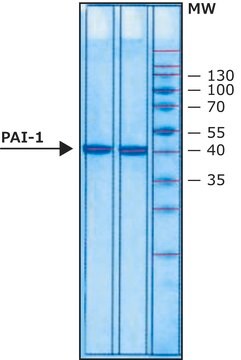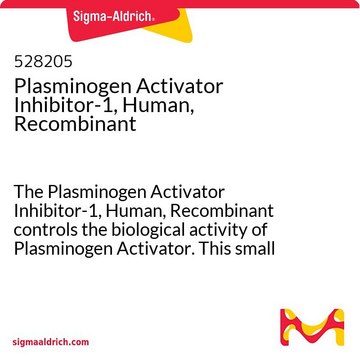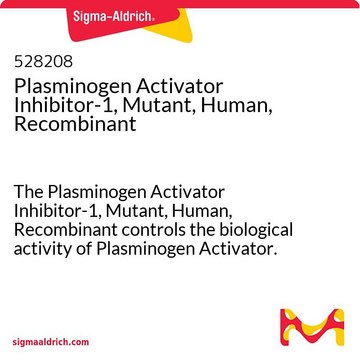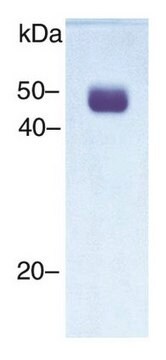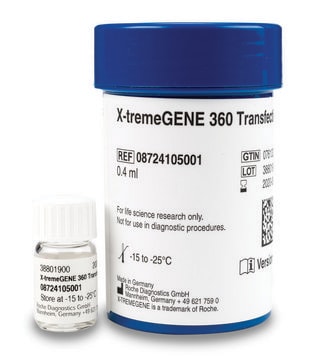CC4075
Human Plasminogen activator inhibitor-1
liquid, ≥98% (SDS-PAGE), suitable for activity assay
Synonim(y):
PAI 1, SERPINE1, PAI1
Zaloguj sięWyświetlanie cen organizacyjnych i kontraktowych
About This Item
Kod UNSPSC:
12352202
eCl@ss:
32160405
NACRES:
NA.77
Polecane produkty
Nazwa produktu
Ludzki inhibitor aktywatora plazminogenu-1, rekombinowany,
pochodzenie biologiczne
human
Poziom jakości
Próba
≥98% (SDS-PAGE)
Formularz
liquid
producent / nazwa handlowa
Chemicon®
metody
activity assay: suitable
zanieczyszczenia
<1 EU/μg endotoxin
numer dostępu NCBI
numer dostępu UniProt
Warunki transportu
dry ice
Opis ogólny
Inhibitor aktywatora plazminogenu-1 (PAI-1) należy do nadrodziny inhibitorów proteaz serynowych (serpin) i jest centralnym białkiem regulatorowym w układzie krzepnięcia krwi. PAI-1 jest unikalny wśród serpin, wykazując różne aktywne i nieaktywne (utajone) konformacje in vivo. Ludzki PAI-1 jest jednołańcuchową glikoproteiną o masie cząsteczkowej 43 kDa. Inhibitor ten działa jako "przynęta" dla tkankowych i urokinazowych aktywatorów plazminogenu (tPA i uPA) oraz białka C. Jego szybka interakcja z tPA może funkcjonować jako główny punkt kontrolny w regulacji fibrynolizy. Uważa się, że wysoce ruchliwa pętla reaktywnego centrum (RCL) odpowiada zarówno za szybkie hamowanie aktywatorów plazminogenu, jak i szybkie i spontaniczne przejście niestabilnej, aktywnej formy PAI-1 do stabilnej, nieaktywnej konformacji (t1/2 w 37oC, 2 godziny). Nieaktywna forma może być częściowo reaktywowana przez denaturanty, takie jak mocznik, chlorowodorek guanidyny lub SDS. Wysokie stężenia PAI-1 są związane z chorobą zakrzepowo-zatorową u ludzi. Aktywność PAI-1 może ograniczać zakres przerzutów nowotworowych, ponieważ aktywność uPA jest głównym czynnikiem przyczyniającym się do rozpuszczania macierzy guza i błony podstawnej.
Sekwencja odpowiadająca aminokwasom od 24 do 402 ludzkiego PAI-1 (forma dojrzała) znakowana 6xHis na końcu karboksylowym została wyrażona w E. Coli.
Zastosowanie
Aby w pełni aktywować utajony PAI-1, PAI-1 musi być inkubowany w buforze aktywacyjnym (2X bufor aktywacyjny: 8 M Guanidine HCl, 40 mM Sodium Acetate, pH 5,6, 400 mM NaCl, 0,2% Tween 20) przez 15 do 30 minut (Sancho, 1994).Rekombinowany PAI-1 jest zdolny do wiązania się z uPA, w wyniku czego powstaje kompleks stabilny w SDS.
Postać fizyczna
Płyn. W 150 mM Na2HPO4, pH 6,6, 500 mM NaCl, 2 mM Glutationu i 0,01% Tween-80.
Przechowywanie i stabilność
Przechowywać w temperaturze -80ºC. Rozmrozić na lodzie i zamrozić podwielokrotności w temperaturze -80ºC w celu dłuższego przechowywania. Ten produkt jest stabilny przez co najmniej 2 lata w stanie, w jakim został dostarczony. Unikać powtarzających się cykli zamrażania/rozmrażania.
Komentarz do analizy
Aktywność swoista: W teście aktywności uPA rekombinowany PAI-1 zawiera mieszaninę aktywnych i utajonych form, z >45% aktywnej formy
Informacje prawne
CHEMICON is a registered trademark of Merck KGaA, Darmstadt, Germany
Oświadczenie o zrzeczeniu się odpowiedzialności
Unless otherwise stated in our catalog or other company documentation accompanying the product(s), our products are intended for research use only and are not to be used for any other purpose, which includes but is not limited to, unauthorized commercial uses, in vitro diagnostic uses, ex vivo or in vivo therapeutic uses or any type of consumption or application to humans or animals.
Ta strona może zawierać tekst przetłumaczony maszynowo.
Kod klasy składowania
10 - Combustible liquids
Klasa zagrożenia wodnego (WGK)
WGK 2
Temperatura zapłonu (°F)
Not applicable
Temperatura zapłonu (°C)
Not applicable
Certyfikaty analizy (CoA)
Poszukaj Certyfikaty analizy (CoA), wpisując numer partii/serii produktów. Numery serii i partii można znaleźć na etykiecie produktu po słowach „seria” lub „partia”.
Masz już ten produkt?
Dokumenty związane z niedawno zakupionymi produktami zostały zamieszczone w Bibliotece dokumentów.
P M Sherman et al.
The Journal of biological chemistry, 267(11), 7588-7595 (1992-04-15)
Plasminogen activator inhibitor-1 (PAI-1) is a specific inhibitor of the serine proteases tissue-type plasminogen activator (tPA) and urokinase-type plasminogen activator (uPA). To systematically investigate the roles of the reactive center P1 and P1' residues in PAI-1 function, saturation mutagenesis was
Nasz zespół naukowców ma doświadczenie we wszystkich obszarach badań, w tym w naukach przyrodniczych, materiałoznawstwie, syntezie chemicznej, chromatografii, analityce i wielu innych dziedzinach.
Skontaktuj się z zespołem ds. pomocy technicznej